The atomic hydrogen model of the Milky Way described here was derived by starting with a simple four-armed spiral model of the Milky Way and then modifying the shape of the spiral arms until the results were compatible with the LAB velocity survey and available radio parallax data. The velocity and parallax data also reveals other spiral structures beyond the four basic arms and I added these to the model as spurs, the ring and the bar.
I used the simple rotation model suggested by Reid et al. 2009 ApJ 700, 137 which assumes that the distance between the sun and the galactic centre is 8400 parsecs and that the galaxy rotates at the constant speed of 254 km/s.
Below I describe each of the four spiral arms and compare the projected velocity from the model with the actual velocity data in the LAB survey. I also note interesting features in the arms.
Centaurus arm
 The Centaurus arm is one of the two major spiral arms of the Milky Way. Astronomers have been unable to agree on its name, and it is also called the Scutum arm, the Crux arm, the Scutum-Centaurus arm, the Scutum-Crux arm, the Crux-Scutum arm, and even the Scutum-Crux-Centaurus arm. As Centaurus is by far the largest of the constellations in whose direction the arm appears, I'll use the term "Centaurus arm".
The Centaurus arm is one of the two major spiral arms of the Milky Way. Astronomers have been unable to agree on its name, and it is also called the Scutum arm, the Crux arm, the Scutum-Centaurus arm, the Scutum-Crux arm, the Crux-Scutum arm, and even the Scutum-Crux-Centaurus arm. As Centaurus is by far the largest of the constellations in whose direction the arm appears, I'll use the term "Centaurus arm".
The Centaurus arm appears to be the most regular of the four spiral arms, with only a slight bend as it passes between the third and fourth quadrants. The arm gradually fades into very cold atomic hydrogen gas in the outer galaxy and its exact terminus is unclear. The terminus in the model is currently set at 85° but could have occurred a bit sooner or later. In 2011, Harvard astronomers traced the Centaurus arm in molecular gas as far as 55°. [Dame, T. M.; Thaddeus, P. 2011]
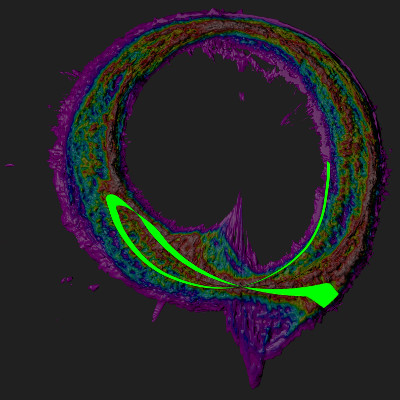
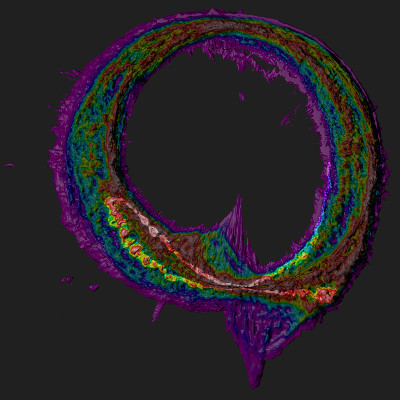
The image on the left shows the expected velocity of the Centaurus arm using the rotation model described above. The image on the right shows the actual corresponding velocity data. The outline of the expected velocity is combined with the actual data for easy comparison in this much more detailed Velocity Explorer image which allows you to cross fade between the combined expected and actual data and the standard LAB velocity image.
The actual velocity data is wider than the expected data based upon the model. This also true of the other spiral arms. One possible explanation for this discrepancy is that star formation regions embedded in the warm hydrogen gas are driving expanding bubbles surrounding them and thus the gas has a local velocity in addition to the velocity created by the rotation of the galaxy. This velocity widening means that we can see structures in the spiral arms at a higher resolution than we would have expected from the rotation model alone. The expanding bubbles act as a kind of velocity magnifying glass. One striking example in the Centaurus arm is the great star formation region G305 which includes the star clusters Danks 1 and 2. You can clearly see filaments that form the boundaries of a bubble surrounding this region in this Velocity Explorer image. This bubble was discussed in Corti, M. A. et.al 2012. However, the Velocity Explorer makes the structure much more obvious.
Although the terminus of the Centaurus arm is unclear, the origin of the arm in an enormous complex of warm hydrogen clouds close to the near end of the galactic bar seems clear in this Velocity Explorer image. This image allows you to cross fade between the combined velocity data and the isosurfaces for the very warm clouds at 90° K.
Norma arm
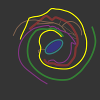 The Norma arm is one of the two minor arms of the Milky Way. This arm is also called the Outer or Cygnus arm. The term "Outer" arm is misleading because it is not in fact the outermost spiral arm in many directions and the term "Cygnus" arm, though common, is a bit confusing because the well known Cygnus complex of star formation regions in the direction of the intense Cygnus X radio source is located in the Orion spur, not the "Cygnus" arm. For these reasons I am following the lead of infrared astronomers and using the term "Norma arm" for this structure.
The Norma arm is one of the two minor arms of the Milky Way. This arm is also called the Outer or Cygnus arm. The term "Outer" arm is misleading because it is not in fact the outermost spiral arm in many directions and the term "Cygnus" arm, though common, is a bit confusing because the well known Cygnus complex of star formation regions in the direction of the intense Cygnus X radio source is located in the Orion spur, not the "Cygnus" arm. For these reasons I am following the lead of infrared astronomers and using the term "Norma arm" for this structure.
The Norma arm is the longest of the spiral arms but does not contain many of the large clouds of hydrogen seen in the more massive Centaurus and Perseus arms. In addition, scientists using the Spitzer infrared telescope report lower infrared emission and a reduced density of red giant stars in the minor Norma and Sagittarius arms compared to the major Centaurus and Perseus arms.
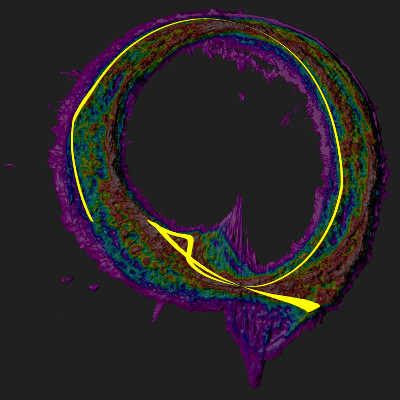
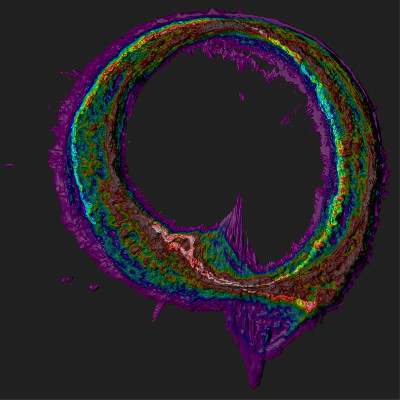
The image on the left shows the expected velocity of the Norma arm using the rotation model described above. The image on the right shows the actual corresponding velocity data. The outline of the expected velocity is combined with the actual data for easy comparison in this much more detailed Velocity Explorer image which allows you to cross fade between the combined expected and actual data and the standard LAB velocity image.
The Norma arm's origin near the origin of the Centaurus arm close to the near side of the galactic bar can be seen in this Velocity Explorer image. The Norma arm terminates by merging with the Sagittarius arm at about 295° as can be seen in this Velocity Explorer image.
The Norma arm closely approaches the far end of the galactic bar in the inner galaxy and there seems to be a spur, the Shepherd spur, which connects the Norma arm directly to the galactic ring. The Shepherd spur is discussed in the section on Milky Way spurs.
From about 37° to 47° the Norma arm velocity is smoothly connected to the Centaurus arm velocity, as can be seen in this Velocity Explorer image. This may be a sign of unusual local velocity in this region, or may reveal that the two arms approach each other here or that there is a large complex of hydrogen clouds that lie between these arms in this region. The current model I am using combines the last two possibilities by assuming that there is a large complex of clouds, the Centaurus confluence, that is located between a close approach of the Norma and Centaurus arms in the outer far galaxy.
Perseus arm
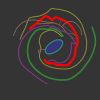 The Perseus arm is one of the two major spiral arms of the Milky Way. Like the Centaurus arm, it contains many massive hydrogen clouds and many red giants prominent in infrared. It is the shortest of the four spiral arms.
The Perseus arm is one of the two major spiral arms of the Milky Way. Like the Centaurus arm, it contains many massive hydrogen clouds and many red giants prominent in infrared. It is the shortest of the four spiral arms.
The origin and terminus of the Perseus arm are both unclear. In the current model I set the origin for the Perseus arm at about 343° as can be seen in this Velocity Explorer image. This is about 15° from the galactic centre and velocities are compressed in this direction, making it difficult to distinguish distinct structures. In addition, as we will see in the section on kinematic ambiguity, the structure shown in the Velocity Explorer as the origin of the Perseus arm at the far end of the galactic bar may actually be much closer. We will likely need more parallax measurements in this region before confirming this structure as the Perseus origin.
The Perseus arm terminates in a large complex of fourth quadrant clouds as can be seen in this Velocity Explorer image.
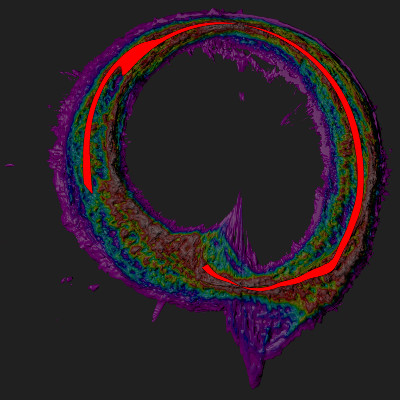
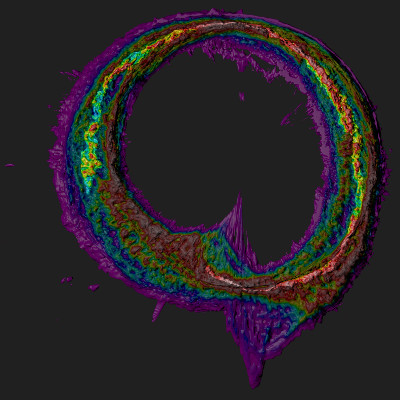
The image on the left shows the expected velocity of the Perseus arm using the rotation model described above. The image on the right shows the actual corresponding velocity data. The outline of the expected velocity is combined with the actual data for easy comparison in this much more detailed Velocity Explorer image which allows you to cross fade between the combined expected and actual data and the standard LAB velocity image.
The Perseus arm is relatively well mapped through parallax in the second quadrant, and the model derived from these measurements between 115° - 160° seems to place the arm closer to the Sun than the main hydrogen clouds. You can see this in this Velocity Explorer image. Since the parallax measurements are based on masers in star formation regions, it might be that these star formation regions are closer than the main hydrogen clouds. Other possibilities are that the Perseus arm in this direction has a widespread local velocity and is effectively falling towards the Sun at a velocity of about 10 km/s or that the star formation regions are rotating more slowly than the hydrogen gas surrounding them.. This discrepancy is not nearly as high as the more than 30 km/s sometimes quoted for rotational models that use a lower figure than 254 km/s for the speed of galactic rotation. [Source needed]
The model includes a major bend in the Perseus arm in the third galactic quadrant. This is consistent with the unusual widening and warping of the Perseus arm velocity in this direction as can be seen in this Velocity Explorer image that shows both the projected velocity from the model (red lines) and the actual velocity. One of the effects of this bend is that we are looking down the Perseus arm between about 220° - 235° rather than across the arm as in other directions. As a result we would expect to see an "overdensity" of spiral arm objects in this direction.
It is interesting to note that Vázquez et.al 2008 reports that "we see young stars clusters and BPs [blue plumes] at any distance between the Sun and the outer arm in this direction .. covering from 230° to 250°", which includes part of the Perseus bend region. Vázquez et.al attribute these objects to the Orion spur rather than the Perseus arm, however. The model used on this site shows the Orion spur extending in the direction of about 260° instead.
Sagittarius arm
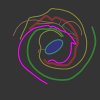 The Sagittarius arm is one of the two minor arms of the Milky Way. It does not contain many of the large clouds of hydrogen seen in the more massive Centaurus and Perseus arms. In addition, scientists using the Spitzer infrared telescope report lower infrared emission and a reduced density of red giant stars in the minor Norma and Sagittarius arms compared to the major Centaurus and Perseus arms. This arm is also called the Carina or Sagittarius-Carina arm.
The Sagittarius arm is one of the two minor arms of the Milky Way. It does not contain many of the large clouds of hydrogen seen in the more massive Centaurus and Perseus arms. In addition, scientists using the Spitzer infrared telescope report lower infrared emission and a reduced density of red giant stars in the minor Norma and Sagittarius arms compared to the major Centaurus and Perseus arms. This arm is also called the Carina or Sagittarius-Carina arm.
In the current model I set the origin for the Sagittarius arm at about 349° as can be seen in this Velocity Explorer image. This is about 11° from the galactic centre and velocities are compressed in this direction, making it difficult to distinguish distinct structures. In addition, as we will see in the section on kinematic ambiguity, the structure shown in the Velocity Explorer as the origin of the Sagittarius arm at the far end of the galactic bar may actually be much closer. We will likely need more parallax measurements in this region before confirming this structure as the Sagittarius origin.
The arm appears to terminate at 352° (as can be seen in this Velocity Explorer image), an area of even greater velocity compression than its origin.
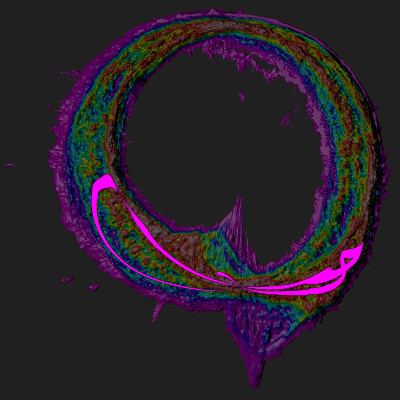
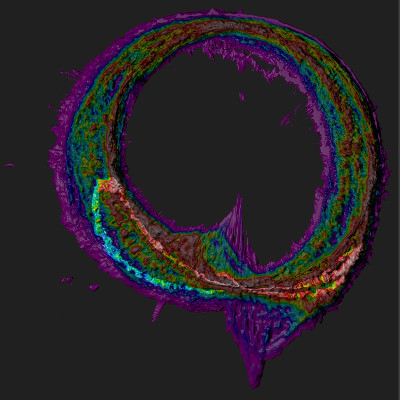
The Sagittarius arm has a complex velocity structure before its tangent at about 54°. This structure can be explained by a bend in the arm between about 40° and 50° which causes the velocity curve to loop and intersect itself.
The Norma arm effectively merges with the Sagittarius arm at about 295° as can be seen in this Face On Explorer image.
The Carina nebula at about 286° is a prominent part of the Sagittarius arm. As can be seen in this Velocity Explorer image, the Carina nebula has an anomalous velocity of about -10 km/s.
